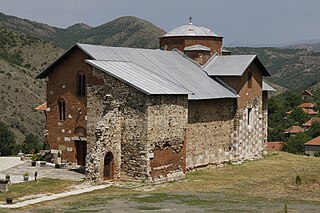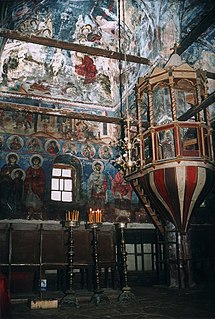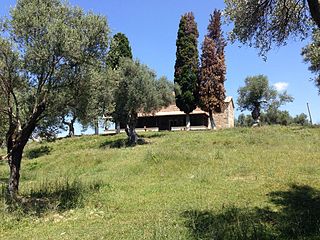
Onufri or Onouphrios of Neokastro was an Orthodox icon painter and Archpriest of Elbasan, active in the 16th century in southern Albania and south-western Macedonia. His works are characterized by post-Byzantine and Venetian influences. He also painted portraits, landscapes, and churches.

Banjska Monastery is a Serbian Orthodox monastery in the Banjska village near Zvečan in Kosovo.

The Albanian art refers to all artistic expressions and artworks in Albania or produced by Albanians. The country's art is either work of arts produced by its people and influenced by its culture and traditions. It has preserved its original elements and traditions despite its long and eventful history around the time when Albania was populated to Illyrians and Ancient Greeks and subsequently conquered by Romans, Byzantines, Venetians and Ottomans.
Lunxhëri is a region in the Gjirokastër County, Albania. It is an ethnographic region along with neighboring regions such as Kurvelesh, Zagoria, Dropull. Its in the periphery of a wider ethnographic region known as Labëria, though its population is said to be non-Lab. Many of its native inhabitants prefer for Lunxhëria to be identified instead as Tosk, as are neighboring regions to the east such as Dangëllia and Kolonja, rather than Lab; some researchers instead prefer to view Lunxhëria as a "transitory region" that is linguistically part of Labëria but culturally part of Toskëria.

The Monastery of the Nativity of the Theotokos in Ardenica or simply Ardenica Monastery is an Eastern Orthodox monastery, distant 18 kilometers north of Lushnje, Albania, along the national road that links Lushnjë to Fier. is an Eastern Orthodox monastery, distant 18 kilometers north of Lushnje, Albania, along the national road that links Lushnjë to Fier.

The National Museum of History is a historical museum in Tirana, Albania. It was opened on 28 October 1981 and is 27,000 square metres in size, while 18,000 square metres are available for expositions.

David Selenica, also commonly known as Selenicasi, was an Albanian Orthodox icon and fresco painter of the Post-Byzantine period in the seventeenth century. He is regarded as one of the most prominent figures of medieval Albanian art besides Onufri and Kostandin Shpataraku.
The brothers Kostandin Zografi and Athanas Zografi were Albanian painters of the 18th century from Dardhë, in modern Korçë municipality, southern Albania. They are regarded as the most prominent painters of the Albanian post-Byzantine icon art of the 18th century and generally of the region of Epirus. Along with David Selenicasi, Kostandin Shpataraku, Terpo Zografi, Efthim Zografi, Gjon Çetiri, Naum Çetiri, Gjergj Çetiri, Nikolla Çetiri, and Ndin Çetiri they represent the School of Korçë painting.

The National Museum of Medieval Art is an Albanian national museum dedicated to medieval art and history in Korçë, Albania. The museum is located on Fan Noli Boulevard in the south-east of the city of Korça. It was established on April 24, 1980 and the building was reconstructed on October 04, 2016 with the cooperation of the city municipality and the Greek Government found.
Saint Gjon Vladimir's Church is a church in Shijon, Elbasan County, Albania. It is dedicated to the Dukljan prince and saint Jovan Vladimir, the son-in-law of the Bulgarian Tsar Samuil. It became a Cultural Monument of Albania in 1948. The first temple is the oldest large Orthodox basilica from the times of Tsar Samuil, rebuilt as present church by the Thopia family in 1381. During the 18th century Kostandin Shpataraku painted the walls of the church.

St. Paraskevi's Church is a church in Çetë, Kavajë Municipality, Albania. It became a Cultural Monument of Albania in 1963.

St. Nicholas' Church, is an Orthodox church in Moscopole, Albania. The church was erected in 1721.

The Forty Saints Monastery is a ruined monastery in Sarandë, Albania, dedicated to the Forty Martyrs of Sebaste.
Constantine of Berat, known among Albanians as Kostandin Jermonak Berati or shortly Kostë Berati, was an Albanian writer and translator of the 18th century.

The Architecture of Albania is a reflection of Albania's historical and cultural heritage. The country's architecture was influenced by its location within the Mediterranean Basin and progressed over the course of history as it was once inhabited by numerous civilisations including the Illyrians, Ancient Greeks, Romans, Byzantines, Venetians, Ottomans as well as modern Austro-Hungarians and Italians. In addition, missionaries, invaders, colonisers and traders brought cultural changes that had a large profound effect on building styles as well as techniques.

The National Iconographic Museum "Onufri" Albanian: Muzeu Kombëtar Ikonografik "Onufri") is an Albanian national museum dedicated to Byzantine art and iconography in Berat, Albania. The museum is located inside the Church of the Dormition of St Mary in the castle quarter Berat. The museum was named to honor Onufri, an Albanian painting Headmaster of the 16th century.















